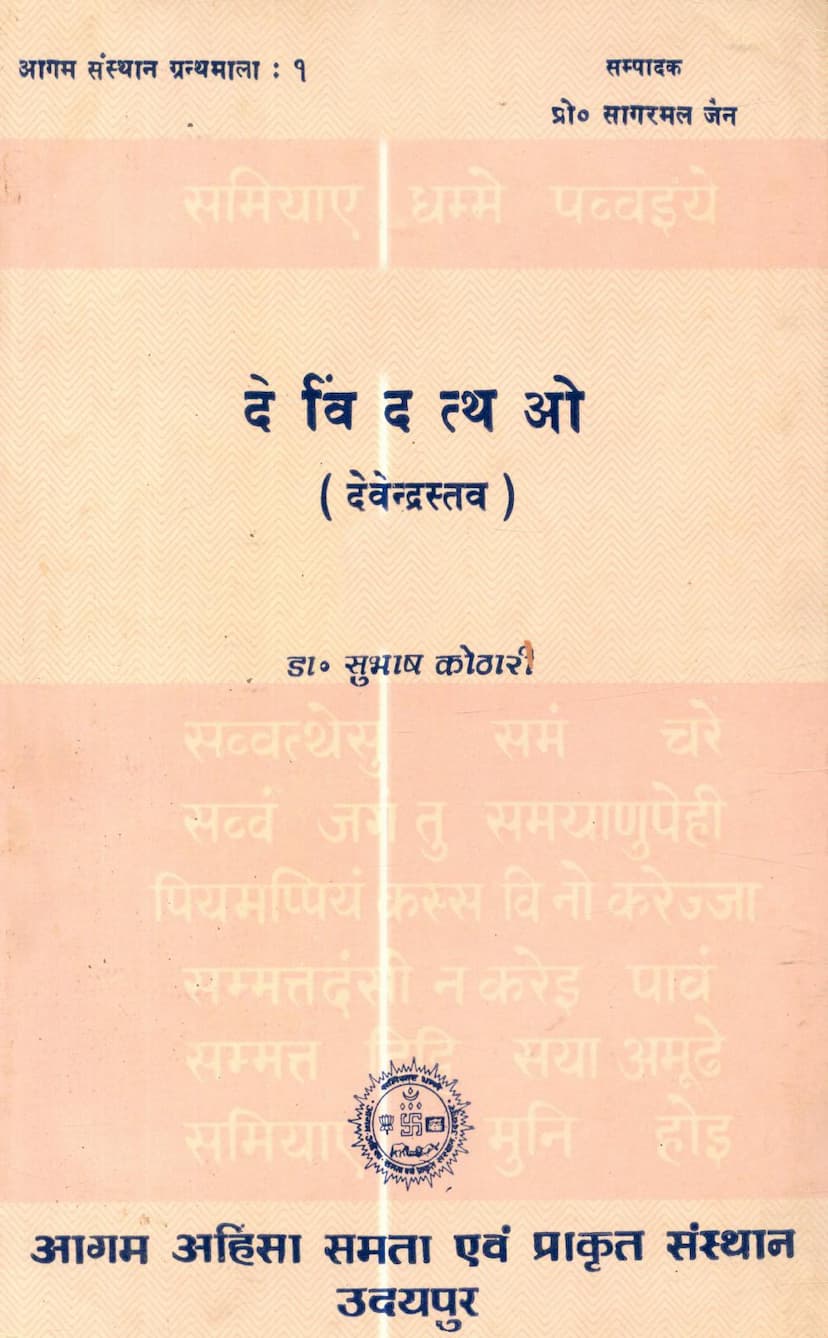Devindatthao
Added to library: September 1, 2025

Summary
Based on the provided Jain text, here's a comprehensive summary in English:
Book Title: Devindatthao (Devendra Stava) Author(s): Dr. Subhash Kothari, Suresh Sisodiya Publisher: Agam Ahimsa Samta evam Prakrit Sansthan, Udaipur Year of Publication: 1988 Catalog Link: https://jainqq.org/explore/004356/1
Overview:
The book "Devindatthao" (also known as "Devendra Stava") is a significant Jain text that was translated and analyzed by Dr. Subhash Kothari with the assistance of Suresh Sisodiya. Published by the Agam Ahimsa Samta evam Prakrit Sansthan, this work is presented as a crucial step in making the rich Ardhamagadhi Jain Agam literature accessible to a wider audience through Hindi translation.
Introduction and Context:
The introduction highlights the importance of Agam literature as an invaluable treasure of Indian culture and literature. It laments the unfortunate lack of translations that has kept this knowledge from the general public and even scholars. The publication of this text is seen as fulfilling a need identified by a coordination committee for Jain studies, aiming to prioritize the translation of Agamic texts and their commentaries.
"Devendra Stava" as a Prakirna Text:
"Devindatthao" is identified as a "Prakirna" text within the Jain Agam tradition. Prakirna texts are generally understood as collections of diverse subjects. While the exact number and names of Prakirna texts vary, "Devendra Stava" is consistently mentioned among them. The text's importance is underscored by its inclusion in the "Utkalika" category of "Angabahya" Agamas according to the Nandi and Paushadhika Sutras. Despite being a Prakirna, its spiritual and linguistic antiquity makes it significant, with some scholars even considering texts like "Rishibhashit" to be older than some older Agamas.
Subject Matter of "Devendra Stava":
The primary focus of "Devendra Stava" is the detailed description of the celestial beings and their realms. It systematically elaborates on:
- Devanikaya (Celestial Beings): The text categorizes and describes the four main classes of celestial beings:
- Bhavanapati Devas: Describing their palaces, cities, numbers, lineage, age, and strength.
- Vanvyantara Devas: Detailing their eight divisions, sixteen Indra names, their dwellings, locations, and lifespans.
- Jyotishka Devas: Explaining the five types (Sun, Moon, Stars, Constellations, Planets), their celestial bodies (viman), their dimensions (length, width, circumference), their movement, and the divine beings who operate them. It includes extensive details on the numbers of celestial bodies in various regions (Jambudvipa, etc.), their speeds, and the mechanics of the Moon's waxing and waning.
- Vaimanika Devas: Describing the twelve Indras of the Kalpavasa Vaimanika Devas, their respective Vimanas, their locations, lifespan, color of their lishyas (aura), their sensual activities, their lifespan, and their palaces. It also delves into the descriptions of Graiveyaka and Anuttara Devas.
- Siddhas: The text concludes by describing the Siddhashila, the abode of liberated souls, their physical characteristics, their spiritual state (free from desire, attachment, etc.), and their infinite knowledge and perception.
- Praise of Tirthankaras: While primarily focused on celestial beings, the text begins and ends with the praise of Tirthankaras, particularly Rishabhanatha and Mahavira. It emphasizes that the glory of Tirthankaras far surpasses that of the heavenly Indras.
Author and Dating:
The text is attributed to Rishipalita (also referred to as Rishi Palita or Rishipal). The dating of the text is placed around the 1st century BCE, based on its linguistic style, subject matter, and its mention in later Agamic texts like Nandi Sutra. The analysis also refutes the attribution to Virabhadra due to chronological discrepancies.
Linguistic and Stylistic Features:
The language of "Devendra Stava" is described as Prakrit, showing some influence of Maharashtri Prakrit, which is also found in other ancient Agamic texts. A unique stylistic feature highlighted is the narrative structure where a dialogue between a householder and his wife explains the celestial descriptions, suggesting a possible intention to present these as worldly beliefs rather than direct pronouncements of the Tirthankaras, thus preserving the spiritual core of Jainism.
Comparative Analysis:
The introduction and appendix provide a comparative analysis of the celestial concepts in "Devendra Stava" with those found in Buddhist traditions, noting similarities and differences in the classification of beings and their realms. It also briefly touches upon the concept of deities in Hinduism, Christianity, and Islam.
Significance and Purpose:
The book is presented as a valuable contribution to Jain scholarship, offering a detailed analysis of a significant Prakirna text. The publication aims to fulfill the need for translated and analyzed Agamic literature, enabling a deeper understanding of Jain cosmology and philosophy. The initiative by the Agam Ahimsa Samta evam Prakrit Sansthan underscores a commitment to preserving and disseminating Jain knowledge.
In essence, "Devindatthao" is an ancient Jain text that meticulously describes the hierarchy, abodes, lifespans, and characteristics of various celestial beings in Jain cosmology. It serves as a testament to the detailed understanding of the universe within the Jain tradition and its effort to make this knowledge accessible through scholarly translation and analysis.